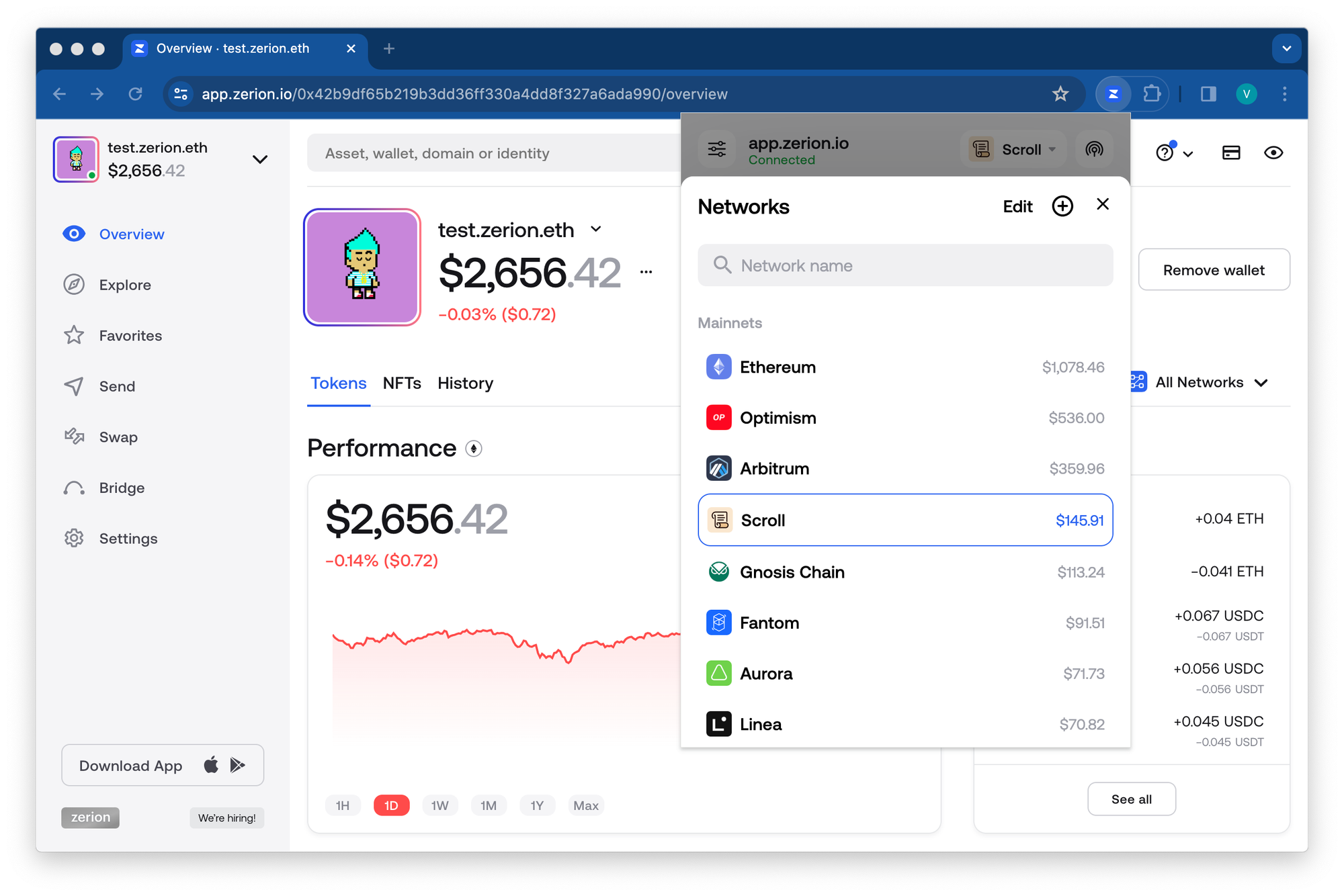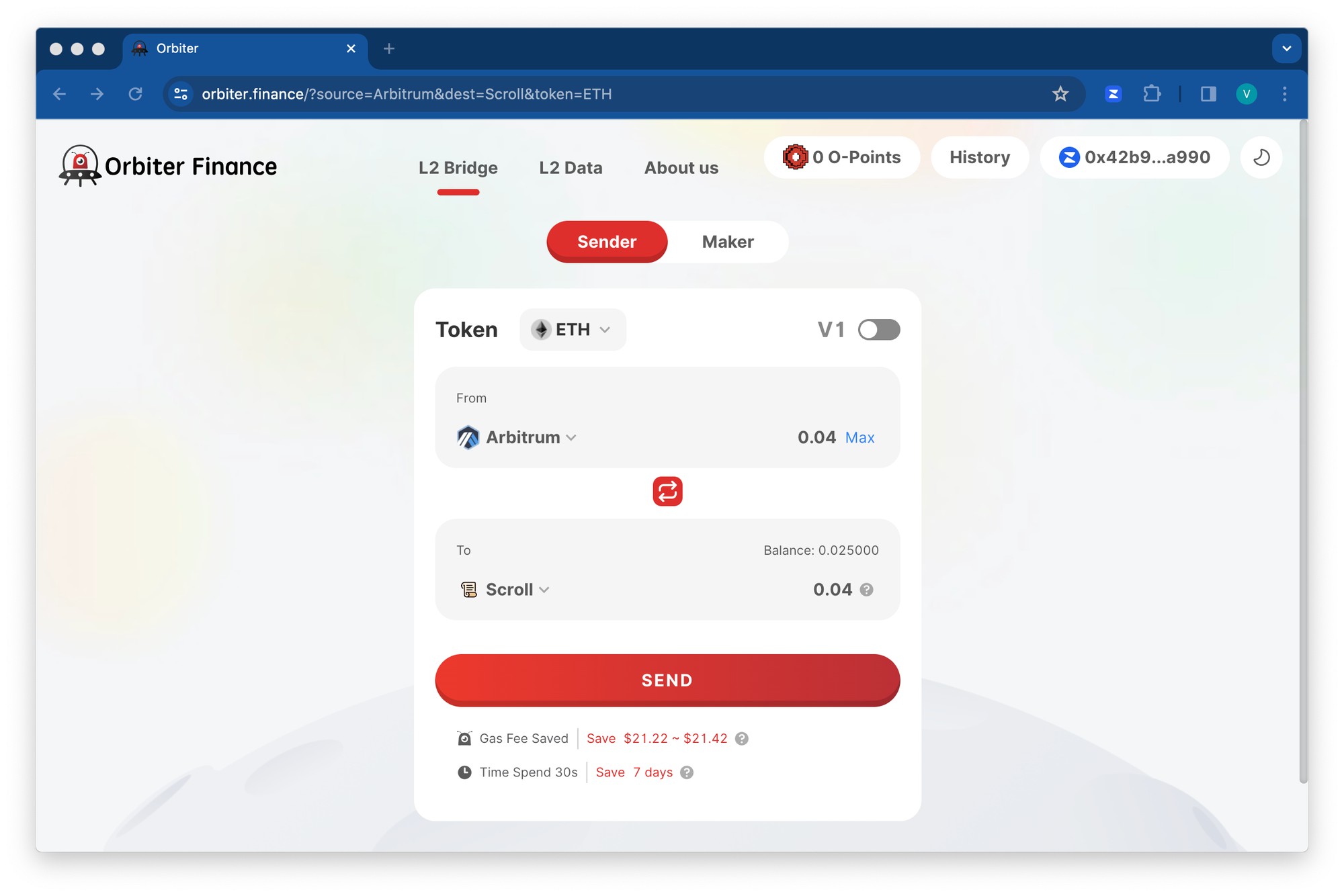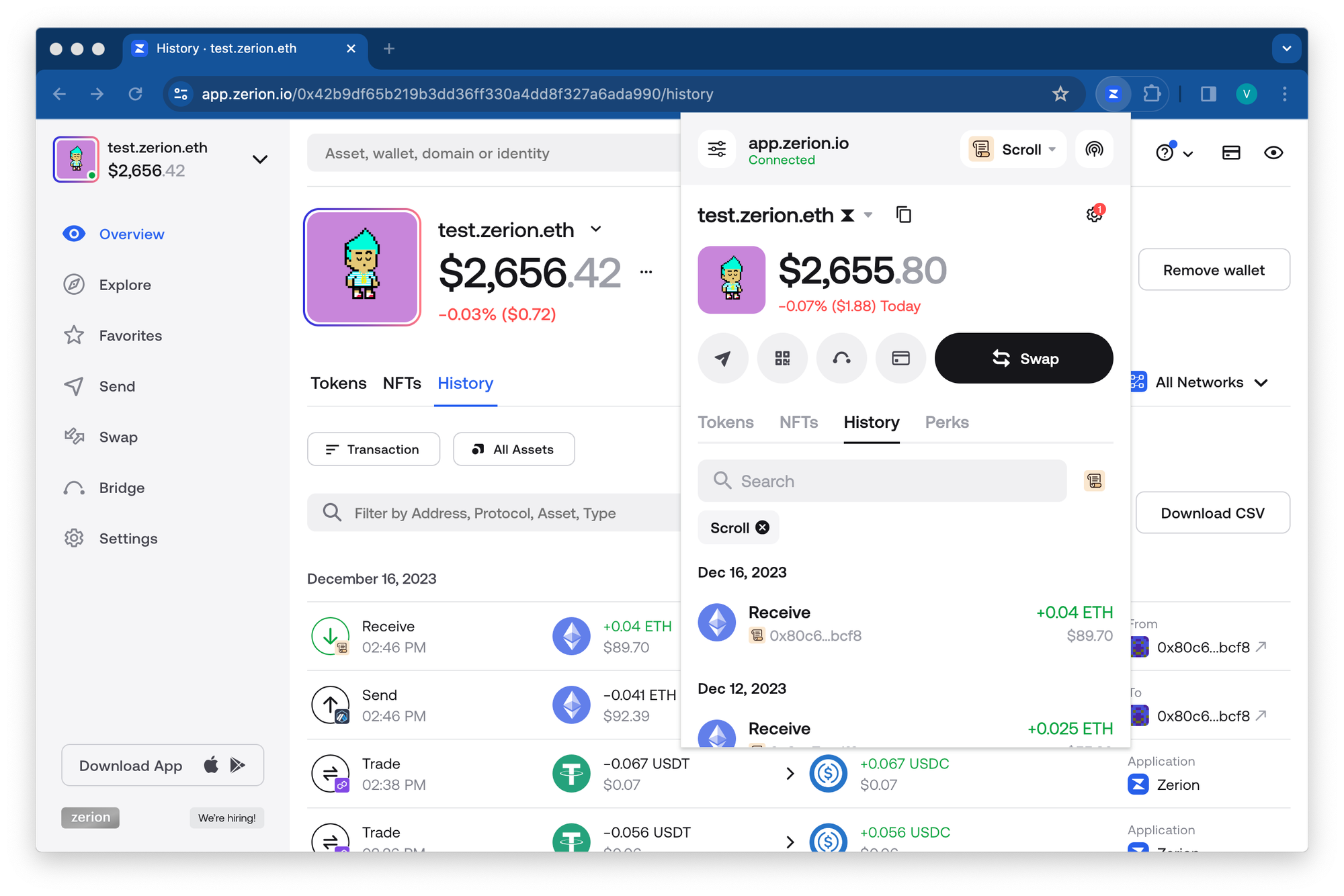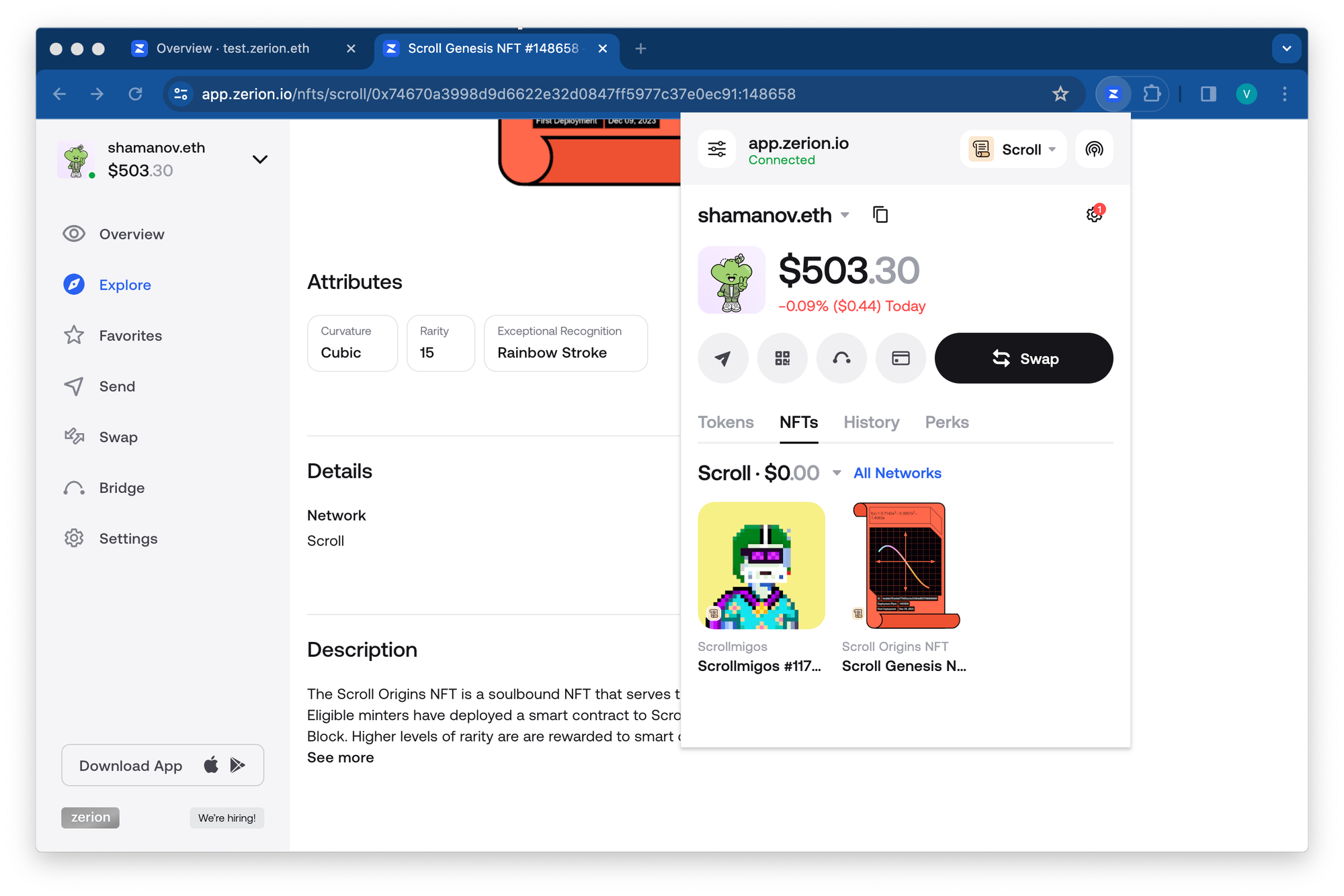Scroll zkEVM is one of the most anticipated Layer-2 networks for scaling Ethereum. Unlike other networks, Scroll didn’t rush to be the first. Yet its focus on credible neutrality, security, and maximum EVM compatibility has helped to build a thriving community. In this post, we’ll dive into what Scroll network is, how it works, and what you can do with it using Zerion Wallet for Scroll.
What is Scroll network?
Scroll is a zkEVM Layer-2 network for scaling Ethereum.
Ok, let’s unpack that.
As a Layer-2 (aka L2) network, Scroll aims to scale Ethereum by executing transactions off-chain and then posting results to the Ethereum blockchain (aka L1). As a zk-rollup, Scroll also submits zero-knowledge validity proofs that the results are correct.
Scroll is EVM, which means it offers an Ethereum Virtual Machine (EVM) that can run smart contracts just like the mainnet Ethereum. Its goal is to make the whole experience as close to the mainnet as possible.
Furthermore, Scroll is compatible on the bytecode level, which means that code, dev tooling, and Solidity work exactly like on Ethereum.
How Does Scroll Mainnet Work?
Under the hood, Scroll uses three layers:
- Sequencing layer that puts L2 transactions into L2 blocks on the Scroll;
- Proving layer that generates zero-knowledge proofs;
- Ethereum as the Settlement layer, where the rollup smart contract exists and provides data availability to the Scroll network.
While you can dig into the technical details, you don’t need to — on the practical level, Scroll works just like Ethereum. You pay for gas with ETH and can use the same wallets.
Even for developers, Scroll EVM is almost exactly the mainnet due to its bytecode compatibility. The list of Scroll’s differences from Ethereum fits into two small tables.
From the user’s perspective, Scroll works just like the mainnet Ethereum. You pay gas with ETH and can use the same address and the same wallet as for the mainnet.
Scroll vs. Other Layer 2s
Scroll is different from not just Optimistic rollups but also from other zkRollups.
First, some zkRollups are zkVM (zk Virtual Machines), and others are zkEVM (zk Ethereum Virtual Machines).
zkVMs are designed to with zero-knowledge proofs in mind and optimize for speed, throughput, or other characteristics. However, it’s harder to port smart contracts from Ethereum to zkVMs.
Meanwhile, on zkEVM, smart contracts from Ethereum can work with minimal changes. Here are examples of zkVM vs zkEVM:
- zkVM: Aztec, Starkware
- zkEVM: Scroll, zkSync
Some zkEVMs also have different compatibility with Ethereum. On EVMs with language-level compatibility, Solidity and other high-level languages work like on Ethereum but compile into a different bytecode. As the name suggests, compatibility at the bytecode-level means that zkEVMs compiles into exactly the same bytecode as Ethereum.
- Language-compatible zkEVM: zkSync
- Bytecode-compatible zkEVM: Scroll
While all this is good to know, you don’t need that to actually using it.
Use Scroll with Zerion Wallet
To use Scroll with Zerion, you first need to get some ETH.
How to add a Scroll network
Unlike in MetaMask and in some other wallets, Scroll is added in Zerion Wallet by default. Once you bridge some assets, the Scroll mainnet will automatically appear in your network list on Zerion.

Bridges
Scroll has its official bridge. However, it only works to and from Ethereum.
Other bridges support a range of Layer-2 (Optimism, Arbitrum, etc) and Layer-1 networks (like BNB). If you have ETH on one of those networks, it’s cheaper and faster to bridge to Scroll.
Orbiter Finance supports over a dozen networks, so let’s use it as an example:
- Connect wallet
- Select Scroll as “to” network
- Select “from” network where you have ETH or other assets — try to avoid Ethereum, which can be pricy. Instead, select a rollup like Optimism or a cheaper L1 like BNB
- Sign transactions

That’s it! Your bridged asset will automatically show up on Scroll in Zerion Wallet. Keep in mind, that a transaction can take a few minutes to show up, depending on the speed of the “from” network.
In Zerion, you’ll see both bridging transactions in your multichain transaction history, both in the Extension and in the web app.

DeFi on Scroll
Scroll already has a fledging DeFi ecosystem with projects that are ported from Ethereum and zkEVMs, as well as native protocols. As of December 2023, Total Value Locked (TVL) isn’t as high as on some older rollups. Yet more and more protocols choose to support Scroll.
- Syncswap — the leading zkEVM-focused DEX, which first started on zkSync
- Sushi — one the biggest fully decentralized DEXes is also available on Scroll
- Ambient — a decentralized trading protocol on Scroll, offering “a better than CEX” experience
Most staked tokens, LPs, and other DeFi positions on Scroll are automatically tracked in Zerion Wallet.
As a developer, you can also use Zerion API for Scroll to fetch wallet data, including token and DeFi positions, transactions, PnL, and more.
NFTs on Scroll
There are already several NFT marketplaces on Scroll.
- Kreatorland — and NFT marketplace and launchpad for L2s
- Element — a gas-saving trading platform for NFTs
Regardless of where you mint or buy Scroll NFTs, you can view them right in Zerion. All NFTs automatically show up in Zerion Wallet. You can also click through into the Zerion web app for an expanded view of the NFT or to sort them by collection, price, date, and more.

What's next
In this post, we explored Scroll zkEVM, looking into what makes it different, how it works, and what you can do with it.
While Scroll’s mainnet is relatively new, it already has a bustling ecosystem with lots of DeFi and NFT projects. With Zerion Wallet, you have everything you need to explore

